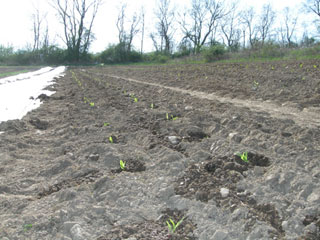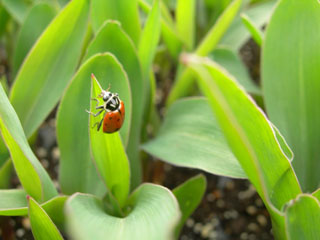
And here are the transplanted corns, awaiting white protective row coverings like those to the left of them, shivering but way ahead of the competition. The trees have not even begun to leaf out.
Because of all the pests that corn tends to attract, most organic farmers steer clear of it. I once talked to a guy who flew crop duster planes over large fields of southern sweet corn in the summer. To effectively disrupt the reproductive cycles of all the different pests, he sometimes flew over those fields every other day. The pesticides he used killed both the good bugs and the bad. (Good bugs are the carnivores that eat the vegetarian "bad bugs" that eat our crops.) As a farmer who does not use any pesticides or herbicides, I prefer a laissez-faire approach: let the good bugs and bad bugs have at it, but give the corn a head start. The Ladybug Benevolent Society wholeheartedly endorses my corn growing technique.

It took four people the better part of a day to plant an acre and a half of corn and then cover it against the chilly spring. Another day will be devoted to hoeing and rototilling the weeds that grow along with the corn. A single conventionally equipped farmer could plant an acre and a half in ten minutes and then go home and read a few chapters of War and Peace before we've finished getting the corn seedlings out of the plug trays. And still, we get some worms… Only a knucklehead would transplant corn like it was a geranium. Few of those resourceful young tractor-fixing whizzes are farmers today. The guy who trapped skunks is an exception. Mike owns three farms and plants a couple hundred acres of field corn every year, using the War and Peace method. Mike is one of the best farmers I know. And he keeps himself busy. His grandchildren are only a few years younger than my daughters. And he has the biggest hay bail throwing hands you could ever imagine. One of these days I'm going to go over to Mike's farm just to take a picture of his hands so you can see what it takes to be a real farmer. (Thanks to Wayne Miller for the photos and to Wayne, Beth Duby, and Eric de Jesus for abetting a knucklehead.)


 Pinterest
Pinterest


